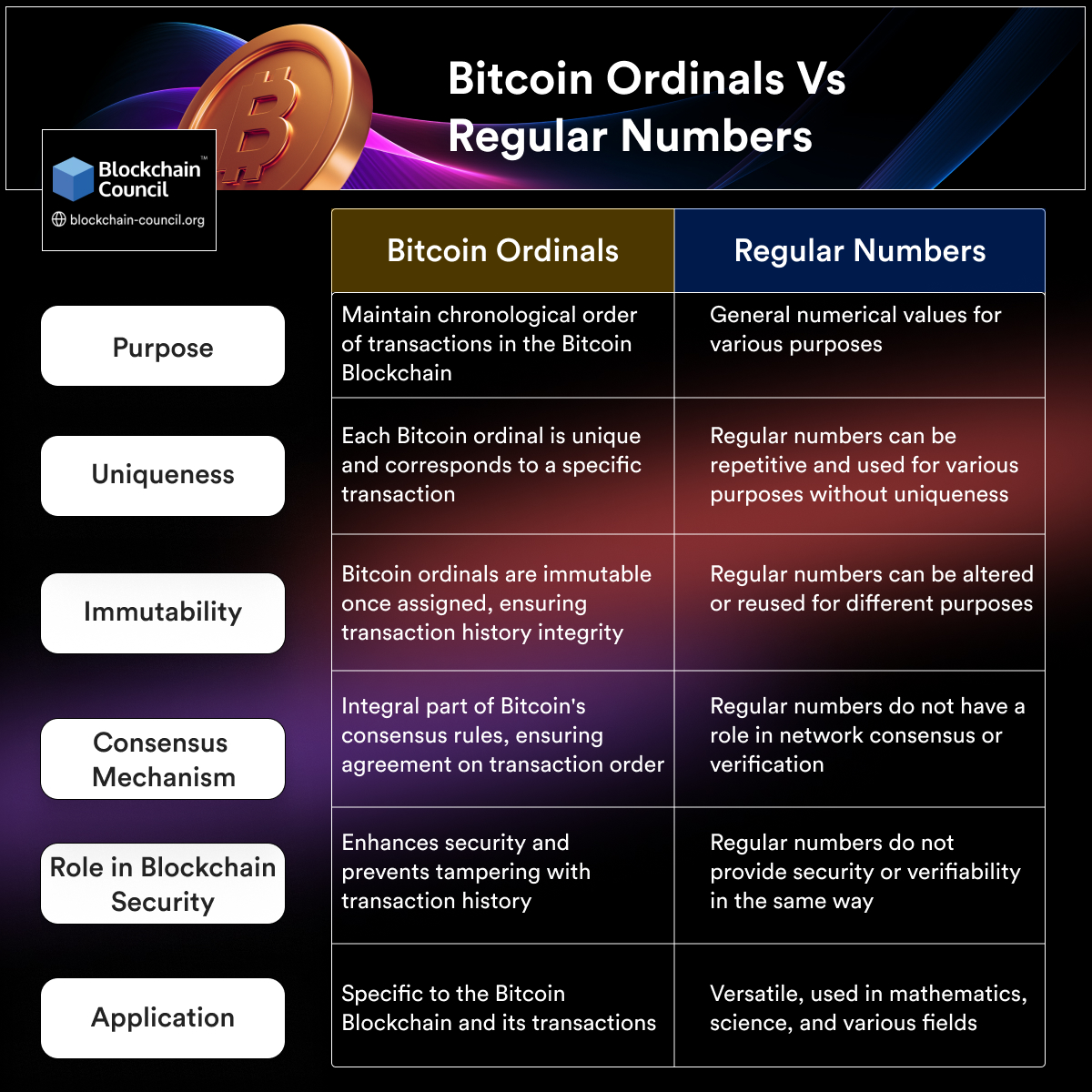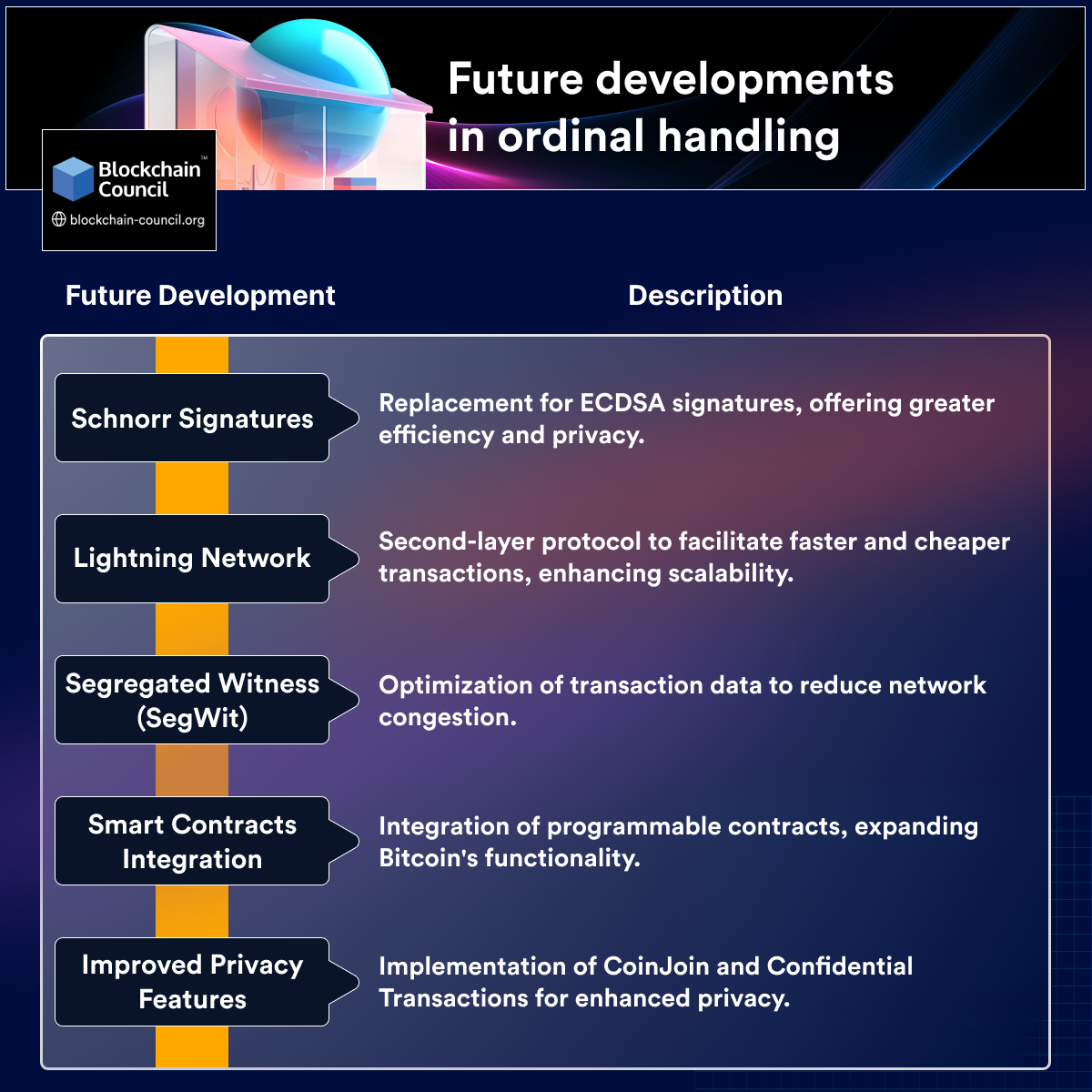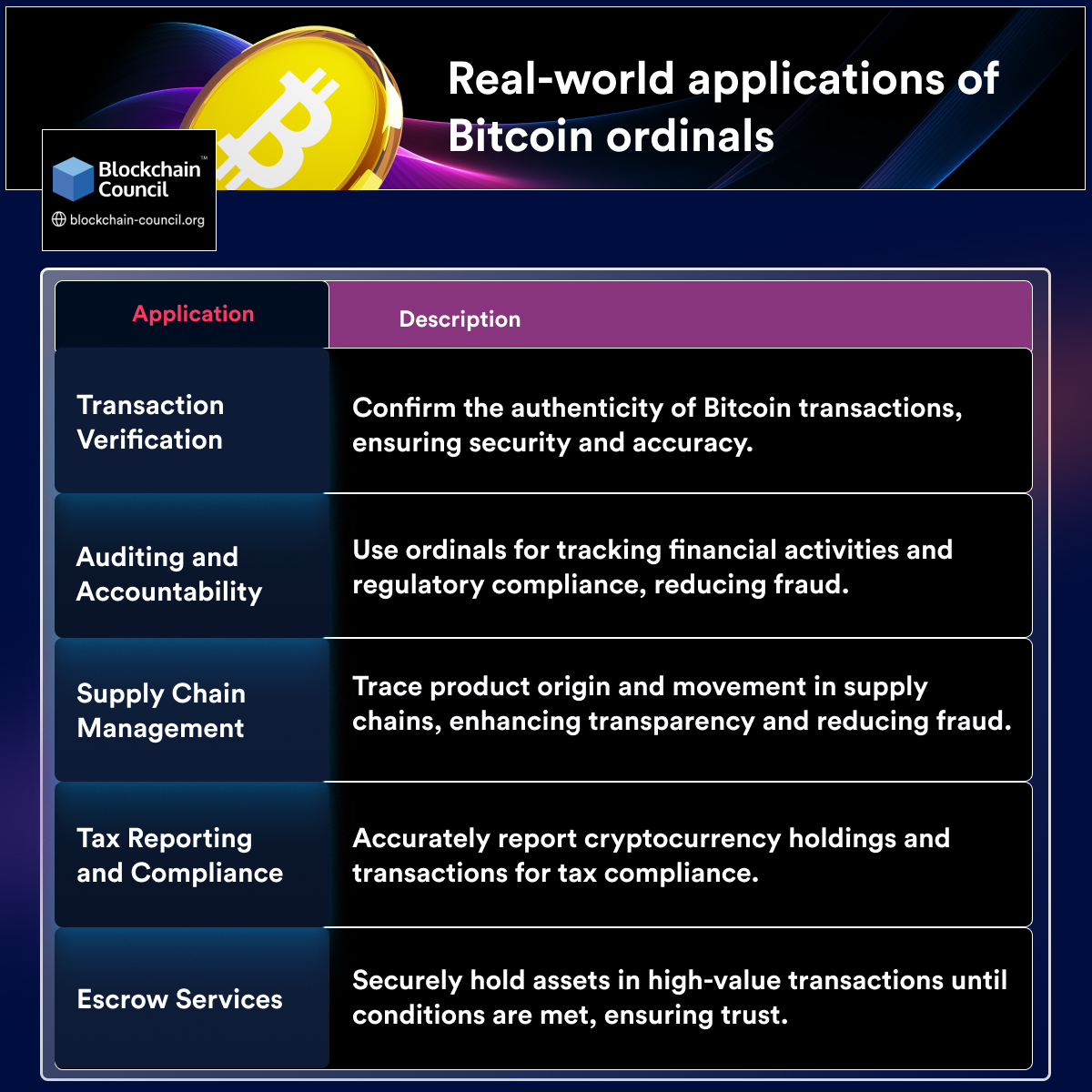
- Blockchain Council
- October 05, 2023
Summary
- Bitcoin ordinals are unique identifiers for transactions on the Bitcoin Blockchain, ensuring chronological order.
- They prevent ambiguity and confusion by uniquely identifying each transaction.
- Bitcoin ordinals have evolved since their introduction by Satoshi Nakamoto.
- They now account for block confirmations, enhancing security and resistance to reorganizations.
- Bitcoin ordinals play a vital role in maintaining the network's consensus rules.
- They enhance security, prevent double-spending, and provide transparency.
- Ordinals are specific to Bitcoin, unlike regular numbers used in various fields.
- Bitcoin ordinals are essential for verifying transaction authenticity and preventing fraud.
- They impact confirmation times, network security, and consensus.
- Bitcoin ordinals have real-world applications, including auditing, supply chain management, and tax reporting.
Introduction
In the ever-evolving realm of cryptocurrencies, Bitcoin stands as the trailblazer, a digital pioneer that has transformed the way we perceive and use money. Its significance reverberates through the world of finance and technology, making it a topic of immense interest for both newcomers and seasoned professionals. However, are Bitcoin transactions totally secure? Notable cases like the 2013 exploit and the 2018 51% attack on Bitcoin Gold highlight vulnerabilities that can be exploited on smaller or less secure Blockchain networks. The crypto winter of 2022 just made the whole scenario harder for crypto enthusiasts around the world.
So, what is the way out? The answer lies in Bitcoin ordinals. But what are Bitcoin ordinals, and why do they matter? This article will cover all the aspects of Bitcoin ordinals, including what they are and why they are so essential to the Bitcoin network. Let’s dive in!
What are Bitcoin Ordinals?
Bitcoin ordinals are a fundamental aspect of the Bitcoin Blockchain, serving as the digital ledger’s equivalent of transaction serial numbers. Ordinals are inscriptions on satoshis, the smallest unit of a Bitcoin. They play a pivotal role in maintaining the integrity, security, and chronological order of transactions within the Bitcoin network. Understanding what Bitcoin ordinals are and why they matter is essential for both beginners and professionals diving into the world of cryptocurrency.
At its core, a Bitcoin ordinal represents the precise position of a transaction within the Blockchain. It’s like a unique identifier for each transaction, ensuring that no two transactions have the same ordinal. This uniqueness is vital because it prevents any ambiguity or confusion when tracking transactions on the decentralized ledger.
Historical context and evolution of Bitcoin ordinals
The concept of Bitcoin ordinals traces back to the early days of Bitcoin development. Satoshi Nakamoto, the pseudonymous creator of Bitcoin, introduced them as a fundamental element of the cryptocurrency’s architecture. Bitcoin ordinals have evolved alongside the Blockchain itself, adapting to the changing needs of the network.
Initially, Bitcoin ordinals were simple numerical values assigned sequentially to transactions. However, as the Bitcoin network grew, scalability became a concern. Bitcoin implemented a hierarchical deterministic (HD) wallet structure to address this. This advancement led to the development of BIP-32, a Bitcoin Improvement Proposal that introduced hierarchical deterministic wallets and extended public keys. These extended public keys, combined with ordinals, revolutionized how Bitcoin addresses are generated and managed.
One significant evolution was the introduction of block confirmations. Bitcoin transactions are not considered final until they are included in a block and blocks are added to the Blockchain. This addition introduced a new layer of complexity to Bitcoin ordinals. Now, they not only denote the order of transactions but also account for the number of blocks added to the Blockchain after a transaction.
This innovation enhances the security of Bitcoin transactions by ensuring that they are resistant to reorganizations or changes in the Blockchain’s history. It provides a clear and unalterable sequence of events, making Bitcoin ordinals an integral part of the network’s consensus rules.
How Bitcoin ordinals differ from regular numbers
1. Purpose
- Bitcoin Ordinals: Bitcoin ordinals serve the primary purpose of maintaining the chronological order of transactions within the Bitcoin Blockchain. Each transaction is assigned a unique ordinal that represents its position in the sequence of transactions.
- Regular Numbers: Regular numbers, on the other hand, are general numerical values used for various purposes in mathematics, science, and everyday life. They are not tied to maintaining the order of transactions or any specific function within a Blockchain.
2. Uniqueness
- Bitcoin Ordinals: Every Bitcoin ordinal is unique within the Blockchain. No two transactions can have the same ordinal, ensuring that each transaction can be precisely identified.
- Regular Numbers: Regular numbers can be repetitive and used for various purposes without the requirement for uniqueness. For example, multiple instances of the number “1” can exist in different contexts without conflict.
3. Immutability
- Bitcoin Ordinals: Once a Bitcoin ordinal is assigned to a transaction, it becomes immutable. This means that it cannot be changed or tampered with, ensuring the integrity of the transaction history.
- Regular Numbers: Regular numbers are not inherently immutable. They can be altered, reused, or modified for different purposes without restrictions.
4. Consensus Mechanism
- Bitcoin Ordinals: Bitcoin ordinals play a crucial role in Bitcoin’s consensus mechanism. They help establish an agreement among network participants about the order and validity of transactions. This consensus is vital for maintaining the security and functionality of the Bitcoin network.
- Regular Numbers: Regular numbers do not have a direct role in network consensus or verification. They are used for a wide range of purposes but do not participate in the consensus process.
5. Role in Blockchain Security
- Bitcoin Ordinals: Bitcoin ordinals enhance the security of the Bitcoin Blockchain by ensuring that the order of transactions is transparent and resistant to tampering. This feature contributes to the overall trustworthiness of the Blockchain.
- Regular Numbers: Regular numbers do not provide the same level of security or verifiability as Bitcoin ordinals. They are not designed to secure transaction histories in the way ordinals do.
6. Application
- Bitcoin Ordinals: Bitcoin ordinals are specific to the Bitcoin Blockchain and are exclusively used for tracking and maintaining the order of transactions within this cryptocurrency ecosystem.
- Regular Numbers: Regular numbers have diverse applications in mathematics, science, finance, and everyday life. They are used for counting, calculations, measurements, and a wide range of purposes beyond the Blockchain.
The Role of Ordinals in Bitcoin
Now that you know, “What are Bitcoin ordinals?” let’s discuss why Bitcoin ordinals matter and its benefits.
Why Bitcoin uses ordinals
Ordinals, in the context of Bitcoin, refer to the order in which transactions are added to the Blockchain. Each transaction receives a unique number or position, known as its ordinal, in the block. But why does Bitcoin use this seemingly complex system?
The answer lies in transparency and security. Bitcoin’s decentralized nature relies on a consensus mechanism known as Proof of Work (PoW). Miners compete to solve complex mathematical puzzles to validate transactions and create new blocks. Ordinals play a pivotal role in this process by ensuring the chronological order of transactions.
Imagine a scenario where there were no ordinals, and transactions were added randomly to the Blockchain. This would create chaos and make it impossible to determine the rightful owner of a specific Bitcoin amount. Ordinals prevent double-spending and ensure that transactions occur in a systematic order, maintaining the integrity of the Blockchain.
Benefits of using ordinals in Blockchain technology
Immutability
Once a transaction receives an ordinal and is added to a block, it becomes a permanent part of the Blockchain. Changing or deleting a transaction would require altering all subsequent transactions, a near-impossible task due to the decentralized and secure nature of Blockchain technology. This immutability ensures that the historical record of transactions remains intact and trustworthy.
Consensus
Miners, who validate transactions through processes like Proof of Work (PoW), rely on ordinals to determine the chronological order in which transactions occurred. This ensures that all nodes within the network agree on the state of the Blockchain. Ordinals help prevent disputes and conflicts by providing a clear and universally accepted transaction history.
Preventing Double-Spending
Ordinals help prevent the double-spending problem. When a transaction is assigned an ordinal and added to the Blockchain, the network recognizes it as “spent.” Any attempt to reuse the same ordinal for a new transaction is flagged as fraudulent, ensuring that a cryptocurrency cannot be spent twice.
Resistance to Tampering
The ordinal system makes it extremely challenging to tamper with past transactions. Once a transaction is included in the Blockchain with its unique ordinal, altering it would require rewriting the entire transaction history, a practically impossible feat due to the computational effort required and the consensus mechanisms in place.
Trust and Transparency
Ordinals enhance trust and transparency within the Blockchain ecosystem. Users can independently verify the validity and order of transactions by examining their ordinals, promoting trust in the network’s integrity.
Timestamping
Ordinals serve as timestamps, indicating the precise position of a transaction within a block and, by extension, its position in the Blockchain’s chronological history. This timestamping is crucial for various use cases, such as auditing and proving ownership or rights to digital assets. It ensures that transactions are processed in the order they are received, maintaining the integrity of the Blockchain’s historical record.
Transparency
Ordinals contribute to the transparency of Blockchain systems by providing a clear and structured order for transactions. This transparency allows users to audit and verify transactions independently. Anyone can examine the Blockchain’s ordinal-based history to confirm the legitimacy of transactions, enhancing trust and accountability within the network. It also facilitates traceability, as transactions can be easily tracked from their ordinal positions.
Ordinals in Bitcoin Transactions
Bitcoin transactions involve several technical aspects, and one crucial element in this cryptographic ecosystem is ordinals.
How Ordinals Are Used in Bitcoin Transactions
In the realm of Bitcoin, ordinals are essentially numerical values assigned to each input in a transaction. These values serve as unique identifiers, ensuring that every input is distinct within the transaction. This distinction is vital for tracking and maintaining the integrity of the transaction history.
When a Bitcoin user initiates a transaction, it typically involves multiple inputs, each representing a different source of funds. These inputs can be thought of as individual “coins” with their own unique ordinals. For example, if a user wants to send 2 BTC and has two 1 BTC coins and one 3 BTC coin in their wallet, each of these coins will have a distinct ordinal.
The ordinals play a critical role in preventing the double-spending problem, a longstanding challenge in digital currencies. By assigning unique ordinals to each input, Bitcoin ensures that the same coin cannot be spent twice in different transactions. This prevents fraud and maintains the integrity of the decentralized ledger.
The Importance of Ordinals in Verifying Transactions
Verifying Bitcoin transactions requires a comprehensive understanding of ordinals. When a user initiates a transaction, the network checks the validity of the ordinals associated with the inputs. It ensures that the ordinals have not been used in previous transactions, confirming that the funds are legitimate and have not been double-spent.
This verification process is crucial for the overall security and trustworthiness of the Bitcoin network. Miners, who validate transactions and add them to the Blockchain, rely on these unique ordinals to ensure that the transactions they include are genuine. This robust verification system is what makes Bitcoin a secure and reliable digital currency.
Protecting Against Double-Spending with Ordinals
Double-spending is the act of attempting to spend the same Bitcoin funds in multiple transactions. Without ordinals, the Bitcoin network would be vulnerable to such fraudulent activities. Ordinals act as a shield against double-spending by providing a clear and unambiguous record of which coins have been used in previous transactions.
When a user tries to spend the same coin in two different transactions, the network immediately detects the conflicting ordinals and rejects the second transaction. This prevents malicious actors from creating counterfeit transactions and maintains the integrity of the entire Bitcoin network.
Ordinals and Transaction Ordering
How ordinals determine the order of transactions in Bitcoin
Understanding how Bitcoin ordinals influence transaction ordering is essential to grasp the inner workings of the network. Let’s break down this process into simple, step-by-step explanations:
Step 1: Transaction Initiation
It all begins when a user decides to send Bitcoin to another party. This transaction is created within their Bitcoin wallet and includes details like the recipient’s address, the amount to be sent, and a transaction fee.
Step 2: Transaction Pool Entry
The newly created transaction enters what is known as the “transaction pool.” This is a temporary holding area for pending Bitcoin transactions.
Step 3: Assigning Ordinals
Each transaction in the pool is assigned a unique ordinal. This ordinal serves as a timestamp, marking the order in which the transaction entered the pool. Think of it like a queue number at a busy store.
Step 4: Miner Selection
Bitcoin miners are responsible for creating new blocks on the Blockchain. They select transactions from the pool to include in the next block they mine.
Step 5: Transaction Selection
Miners prioritize transactions based on the transaction fees attached to them. Transactions with higher fees are more attractive to miners because they earn more for including them in a block.
Step 6: Building the Block
Miners gather a set of transactions, typically in the order of their assigned ordinals, to create a new block. This block includes a reference to the previous block, ensuring the chronological continuity of the Blockchain.
Step 7: Proof of Work
Miners compete to solve a cryptographic puzzle known as “proof of work.” The first miner to solve it gets to add their block to the Blockchain.
Step 8: Block Confirmation
Once a miner successfully adds a block to the Blockchain, the included transactions are considered confirmed. Confirmation means that the transaction is irreversible and recorded in the Blockchain’s history.
Step 9: Consensus Building
The inclusion of transactions in a block is agreed upon by the entire Bitcoin network, ensuring a consensus on the transaction order. This consensus is critical for the security and integrity of the network.
Step 10: Maintaining Sequence
The ordinal system ensures that transactions are processed in the order they entered the transaction pool. This prevents double-spending and maintains the chronological integrity of the Blockchain.
Implications of Transaction Ordering for the Bitcoin Network
Transaction ordering has significant implications for the Bitcoin network. One key aspect is the confirmation time. Transactions with higher fees typically get processed faster because miners are incentivized to include them in the next block. This affects the user experience, as faster confirmations provide peace of mind to both senders and receivers.
Moreover, transaction ordering influences the security of the network. By assigning ordinals and following a specific order, Bitcoin ensures that each transaction builds upon the previous ones. This sequential structure adds a layer of security, making it extremely difficult for malicious actors to manipulate the order of transactions and compromise the integrity of the Blockchain.
Preventing Conflicts and Ensuring Consensus with Ordinals
Bitcoin’s decentralized nature relies on consensus among participants. Ordinals play a crucial role in achieving this consensus. When all nodes in the network agree on the order of transactions, it prevents conflicts and maintains the integrity of the Blockchain.
Imagine two conflicting transactions attempting to spend the same Bitcoin. The ordinal system ensures that only one of these transactions can be included in a block, as they cannot have the same ordinal. This prevents double-spending and ensures that all participants in the network have a consistent view of the transaction history.
Ordinals and Block Validation
The Role of Ordinals in Validating Blocks in the Bitcoin Blockchain
Ordinals, in the context of Bitcoin, are unique numerical identifiers assigned to each transaction output (UTXO) within a block. These identifiers help maintain the chronological order of transactions and ensure the transparency and immutability of the Blockchain.
When a Bitcoin transaction is included in a block, it receives an ordinal number. This number reflects the order in which the transaction was added to the block. This seemingly simple concept carries significant weight, as it plays a critical role in verifying the validity of transactions and blocks.
Blockchain nodes use ordinals to track the history of UTXOs. This tracking is essential for ensuring that double-spending or other malicious activities are detected and prevented. By following the sequence of ordinals, nodes can verify that a UTXO has not been spent twice, maintaining the integrity of the entire Blockchain.
Ensuring the Integrity of the Blockchain Through Ordinals
Bitcoin’s security is underpinned by its decentralized nature and the cryptographic principles it employs. However, ordinals add an extra layer of protection. By assigning unique identifiers to transactions, Bitcoin ensures that the order of transactions is maintained throughout the network.
This chronological order is crucial for preventing fraud and ensuring that the Blockchain remains a tamper-resistant ledger. Any attempt to alter the order of transactions would require an inordinate amount of computational power, making it virtually impossible.
Ordinals contribute to the overall transparency of Bitcoin. Anyone can inspect the Blockchain and verify the sequence of transactions. This transparency is fundamental to Bitcoin’s ethos of trustlessness and decentralization.
Addressing Potential Attacks Using Ordinals
Bitcoin’s design anticipates various potential attacks, and ordinals play a vital role in thwarting some of these threats. One such threat is the “Finney attack,” where an attacker attempts to double-spend by mining a block containing a conflicting transaction immediately after a target transaction.
Ordinals help in identifying these attacks. When the attacker’s block is added to the Blockchain, it disrupts the chronological order of transactions. This irregularity is easily detected by other nodes, and the attempted double-spend can be rejected.
Additionally, ordinals contribute to the robustness of the Bitcoin network against reorganizations. In the rare event of a Blockchain reorganization, where a longer chain replaces the previously accepted one, ordinals help nodes determine the correct sequence of transactions, maintaining the Blockchain’s integrity.
Challenges with Ordinals
Common issues and challenges related to Bitcoin ordinals
Bitcoin ordinals refer to the position of a transaction within a block’s order. One common challenge is the potential for double-spending. In simple terms, this means a user may attempt to spend the same Bitcoin twice. Bitcoin’s solution to this problem involves confirming transactions through a process called mining.
Mining, while essential, presents another challenge: it consumes a significant amount of computational power and energy. This not only impacts the environment but also raises concerns about the scalability of the Bitcoin network.
Scalability concerns and solutions
Increasing Transaction Volume
As Bitcoin gains popularity, the number of transactions being processed on the network increases. This surge in transaction volume can lead to delays and higher fees, making it less efficient for users.
Lightning Network (Solution)
The Lightning Network is a second-layer solution designed to alleviate the concern of increasing transaction volume. It allows users to create payment channels off the main Bitcoin Blockchain. Transactions within these channels can be conducted instantly and with minimal fees, offering a scalable way to handle a large number of transactions without burdening the main network.
Energy Consumption due to Mining
Bitcoin relies on a process called mining to confirm transactions and add them to the Blockchain. Mining requires a substantial amount of computational power and energy, which has raised environmental concerns.
Segregated Witness (SegWit) (Solution)
Segregated Witness is a solution aimed at reducing the energy consumption concern. It optimizes transaction data by separating the transaction signatures (witness data) from the transaction itself. This reduces the size of transactions, leading to faster confirmation times and lower energy consumption.
Network Congestion
As more users and transactions join the Bitcoin network, it can become congested, causing delays in transaction confirmations and potentially higher fees.
Schnorr Signatures (Solution)
Schnorr signatures are considered a more efficient cryptographic signature scheme compared to the current elliptic curve digital signatures (ECDSA) used in Bitcoin. Implementing Schnorr signatures could improve the overall scalability of Bitcoin by reducing the size of signature data in transactions, thereby increasing the number of transactions that can fit into a block.
Delayed Confirmation Times
Delayed confirmation times can be frustrating for users, especially in situations where fast transactions are required.
Increasing Block Size
One proposed solution to the concern of delayed confirmation times is to increase the block size. This would allow more transactions to be included in each block, theoretically reducing congestion and confirmation delays. However, this approach is controversial as it may lead to centralization and other potential issues.
High Transaction Fees
When the network is congested, users may need to pay higher fees to ensure their transactions are processed promptly.
Integration of Layer 2 Solutions
To address high transaction fees, Bitcoin can integrate additional layers (Layer 2 solutions) that handle transactions off the main Blockchain. These layers, like the Lightning Network, provide a way to conduct transactions more cost-effectively and quickly, reducing the reliance on high fees during network congestion.
Future developments in ordinal handling
Use Cases of Bitcoin Ordinals
Real-world applications of Bitcoin ordinals
Bitcoin ordinals, at their core, are numerical representations of transactions on the Bitcoin Blockchain. They are like digital fingerprints that uniquely identify each transaction. This uniqueness makes them invaluable in various real-world scenarios.
- Transaction Verification: One of the fundamental use cases of Bitcoin ordinals is transaction verification. When you send or receive Bitcoin, you can use the ordinals to confirm the authenticity of the transaction. This feature is particularly crucial for businesses, financial institutions, and individuals who want to ensure that their transactions are secure and accurate.
- Auditing and Accountability: Bitcoin ordinals provide an immutable record of transactions. This makes them a powerful tool for auditing and accountability. Companies and organizations can use ordinals to track financial activities and verify compliance with regulations. This not only reduces the risk of fraud but also simplifies the auditing process.
- Supply Chain Management: The transparency and immutability of Bitcoin ordinals make them suitable for supply chain management. Companies can use ordinals to trace the origin and movement of products through the supply chain. This enhances transparency, reduces fraud, and ensures the quality of goods.
- Tax Reporting and Compliance: Tax authorities worldwide are increasingly recognizing the importance of Bitcoin ordinals in tracking cryptocurrency transactions. Individuals and businesses can use ordinals to report their cryptocurrency holdings and transactions accurately, ensuring compliance with tax regulations. This helps in preventing tax evasion and streamlines the tax reporting process, benefitting both taxpayers and governments.
- Escrow Services: Bitcoin ordinals are also utilized in escrow services, where a trusted third party holds assets until certain conditions are met in a transaction. By using ordinals, all parties involved can confirm that the conditions have been fulfilled, enabling a smooth and secure transfer of assets. This is particularly valuable in high-value transactions, such as real estate purchases, where trust and security are paramount.
How ordinals enable smart contracts and complex transactions
Bitcoin ordinals play a pivotal role in the world of smart contracts and complex transactions. Smart contracts are self-executing contracts with the terms of the agreement directly written into code. Bitcoin ordinals facilitate these contracts in the following ways:
- Conditional Payments: Smart contracts can be programmed to release payments automatically when specific conditions are met. Bitcoin ordinals ensure that these conditions are accurately tracked and executed, reducing the need for intermediaries and minimizing the risk of disputes.
- Multi-Signature Wallets: Bitcoin ordinals are often used in multi-signature wallets, where multiple parties must sign off on a transaction. This adds an extra layer of security and control, making them ideal for businesses and organizations that require collaborative decision-making.
Examples of innovative uses of ordinals in Bitcoin
The versatility of Bitcoin ordinals has sparked creativity in the cryptocurrency space. Here are some innovative examples:
- Tokenization of Assets: Bitcoin ordinals can be used to tokenize real-world assets such as real estate, art, or stocks. These tokens represent ownership and can be traded on Blockchain-based platforms, democratizing access to traditionally illiquid assets.
- Decentralized Autonomous Organizations (DAOs): DAOs are organizations run by code and governed by their members. Bitcoin ordinals ensure transparency in decision-making and fund management within these decentralized entities.
- Cross-Border Remittances: Bitcoin ordinals simplify cross-border remittances by reducing the time and cost associated with traditional banking systems. Individuals can send Bitcoin with confidence, knowing that the ordinals provide a clear record of the transaction.
- Ordinal Punks: Ordinal Punks is a collection of 10,000 randomly generated pixel art characters that are stored on the Bitcoin Blockchain. Ordinal Punks are some of the first NFTs to be created on Bitcoin, and they have quickly become a popular collection among collectors.
- Ordinal Bible: The Ordinal Bible is a complete copy of the King James Version Bible that has been inscribed on the Bitcoin Blockchain. The Ordinal Bible is a significant achievement, as it demonstrates the potential of ordinals to be used to store large amounts of data on the Bitcoin network.
- Ordinal Theory: Ordinal Theory is a project that is developing a decentralized storage solution that is built on top of the Bitcoin network. Ordinal Theory will allow users to store arbitrary data on the Bitcoin Blockchain in a secure and tamper-proof way.
Security and Cryptography
Cryptographic Principles Behind Bitcoin Ordinals
At the heart of Bitcoin ordinals lies the fascinating world of cryptography. In simple terms, cryptography is the art of securing information through encryption techniques. Bitcoin ordinals leverage this cryptographic wizardry to safeguard transactions and user identities.
To delve into the specifics, Bitcoin ordinals are generated using cryptographic algorithms, employing concepts like public and private keys. These keys act as digital signatures, ensuring that only authorized parties can initiate transactions. Here’s how it works:
When someone wants to make a Bitcoin transaction, they use their private key to create a unique digital signature. This signature is a cryptographic proof that the transaction is legitimate and hasn’t been tampered with. It also verifies the sender’s identity without revealing their private key.
The recipient can then use the sender’s public key to verify the signature and ensure that the transaction is valid. This process is at the core of Bitcoin’s security, and it all happens thanks to cryptographic principles.
Ensuring the Security of Ordinals in the Bitcoin Ecosystem
Security is paramount in the realm of Bitcoin, where millions of dollars are exchanged daily. Bitcoin ordinals contribute significantly to this security. They protect the integrity of transactions and the privacy of users.
When you make a Bitcoin transaction, your ordinal is like a secret code that ensures your funds go to the intended recipient. It’s practically impossible for anyone to decipher this code without the corresponding private key. This robust security mechanism prevents fraud and unauthorized access to funds.
Additionally, ordinals play a crucial role in safeguarding user identities. They allow individuals to make transactions pseudonymously, without revealing their real-world identities. This privacy feature is a cornerstone of Bitcoin’s appeal.
Potential Vulnerabilities and Mitigations
While Bitcoin ordinals offer robust security, no system is entirely immune to vulnerabilities. One potential risk is the loss of private keys. If you lose your private key, you lose access to your Bitcoin. There’s no central authority to recover it for you, making it vital to keep your keys secure.
Another concern is the possibility of a brute force attack, where an attacker attempts to guess a private key. This is exceedingly difficult due to the vast number of possible keys, but it’s essential to use strong, unique keys to minimize this risk.
To mitigate these vulnerabilities, users are advised to use secure wallets and backup their private keys diligently. Hardware wallets, for instance, offer an added layer of protection. Moreover, staying informed about the latest security practices is crucial in the ever-evolving world of cryptocurrencies.
How to Make the Most of Bitcoin Ordinals? Get Certified Today!
If you’re serious about harnessing the full potential of Bitcoin ordinals, there’s a crucial step you should consider: becoming a Certified Bitcoin Expert. This certification isn’t just a badge; it’s your key to understanding and utilizing Bitcoin ordinals to their fullest.
What is the Certified Bitcoin Expert™ Certification?
The Certified Bitcoin Expert™ (CBE) certification is an expert-led program tailored to equip individuals with in-depth knowledge of Bitcoin and its intricacies, including the pivotal role of Bitcoin ordinals. This certification is a game-changer for anyone looking to elevate their understanding of cryptocurrency and Blockchain technology.
Why is CBE Certification Important for Bitcoin Ordinals?
- Technical Proficiency: To effectively work with Bitcoin ordinals, you need a deep understanding of Blockchain technology. CBE certification provides you with the technical proficiency required to navigate this complex landscape.
- Career Advancement: As a Certified Bitcoin Expert™, you’re positioned for significant career growth. Employers in the Blockchain and cryptocurrency industry highly value this certification, making it a catalyst for your professional journey.
- Enhanced Decision-Making: Bitcoin ordinals play a pivotal role in transaction verification and security. With CBE certification, you’ll have the knowledge to make informed decisions in using Bitcoin ordinals to safeguard transactions.
- Industry Recognition: The CBE certification is widely recognized in the cryptocurrency domain. It’s a testament to your expertise, setting you apart in a competitive field.
- Lifetime Validity: Once you earn the CBE certification, it’s yours for a lifetime. This means you can continually apply your knowledge of Bitcoin ordinals to stay at the forefront of cryptocurrency developments.
Future Trends and Developments
Anticipated Developments in Bitcoin Ordinals Technology
Bitcoin ordinals, also known as Bitcoin scripts or scriptPubKeys, are essential in executing smart contracts and facilitating complex transactions on the Bitcoin network. In the coming years, we can expect several significant developments in this technology:
- Enhanced Scripting Capabilities: Bitcoin developers are constantly working on improving the scripting language, allowing for more complex and flexible smart contracts. This will open up new possibilities for decentralized applications (dApps) and financial instruments built on the Bitcoin Blockchain.
- Privacy Features: As privacy becomes a growing concern in the cryptocurrency space, we can anticipate advancements in Bitcoin ordinals that enhance transaction privacy. These developments may include confidential transactions and improved coin mixing techniques.
- Scalability Solutions: Scalability has been a longstanding challenge for Bitcoin. Future developments in Bitcoin ordinals may address this issue by enabling off-chain solutions like the Lightning Network to process transactions more efficiently while still benefiting from the security of the Bitcoin Blockchain.
The Role of Ordinals in the Future of Blockchain and Cryptocurrency
Bitcoin ordinals are not limited to Bitcoin alone; they have the potential to influence the entire Blockchain and cryptocurrency industry:
- Interoperability: As Blockchain networks continue to proliferate, Bitcoin ordinals can serve as a bridge between different Blockchains, enabling interoperability. This would allow assets to move seamlessly across various Blockchain ecosystems.
- Security and Trust: Bitcoin’s robust security features, including its ordinals, make it a trusted anchor for other Blockchain networks. In the future, we may see more tokens and assets secured by Bitcoin through atomic swaps and cross-chain transactions.
- Decentralized Finance (DeFi): DeFi is one of the fastest-growing sectors in the cryptocurrency space. Bitcoin ordinals can play a pivotal role in bringing DeFi capabilities to Bitcoin, enabling lending, borrowing, and yield farming while maintaining the network’s security
Research and innovation in the field of ordinals
Ordinals in the Bitcoin ecosystem are a recent and groundbreaking development that holds immense potential to transform how Bitcoin is utilized. Ordinals enable users to inscribe arbitrary data onto Bitcoin transactions, opening up a range of exciting possibilities:
- Bitcoin NFTs: Ordinals have made it possible to create non-fungible tokens (NFTs) on the Bitcoin Blockchain, a significant leap forward for Bitcoin, which was not initially designed for NFTs. While still in its early stages, this technology can revolutionize Bitcoin by introducing new forms of digital ownership and collections.
- Decentralized Storage: Ordinals enable the storage of diverse data types, including images, videos, documents, and code, directly on the Bitcoin Blockchain. This feature paves the way for decentralized storage solutions built on top of the Bitcoin network.
- Digital Identity: With ordinals, it’s feasible to establish digital identities linked to the Bitcoin Blockchain. This has applications in online verification, voting, and other identity-related use cases.
- Metaverse Integration: Ordinals can facilitate Bitcoin’s integration into the metaverse, where they can represent digital assets like virtual land within virtual worlds. This has the potential to bridge the digital and physical worlds seamlessly.
- New Financial Instruments: Ordinals can be harnessed to create innovative financial instruments such as decentralized derivatives and synthetic assets. This expansion of Bitcoin’s utility may attract a broader range of investors.
In the realm of research and innovation related to ordinals, here are key areas of focus:
- Scaling Solutions: As ordinals can increase the size and cost of Bitcoin transactions, researchers are actively working on scaling solutions to make ordinals transactions more efficient and cost-effective.
- Tool and Application Development: With the growing interest in ordinals technology, an ecosystem of tools and applications is emerging, making it easier to leverage ordinals for various purposes.
- Ordinal Smart Contracts: Ordinal smart contracts have the potential to enable complex and sophisticated applications on the Bitcoin network, such as decentralized exchanges and lending platforms.
- Ordinal Oracles: These oracles can bring real-world data onto the Bitcoin Blockchain, facilitating the creation of applications that respond to real-world events.
- Ordinal Cross-Chain Bridges: Ordinal cross-chain bridges are under development to connect the Bitcoin network with other Blockchains, enabling seamless asset transfers between different Blockchain ecosystems.
Conclusion
Bitcoin ordinals may sound complex at first, but they play a vital role in the world of cryptocurrencies. As we’ve explored throughout this article, they are essentially a way to keep track of transactions on the Blockchain. Now that you know the answer to “What are Bitcoin ordinals and why do they matter?”, it is crucial to upskill yourself with cryptocurrency certifications like the Certified Bitcoin Expert™ from a reputed organization like the Blockchain Council.
These seemingly random numbers hold the key to understanding the chronological order of transactions, ensuring transparency, security, and the overall integrity of the Bitcoin network. Whether you’re a newcomer or a seasoned crypto enthusiast, grasping the significance of Bitcoin ordinals is essential.
By dissecting the technical aspects and diving into the nitty-gritty details, we’ve demystified the concept of Bitcoin ordinals. They matter because they form the backbone of Bitcoin’s decentralized nature and underpin its trustworthiness.
Frequently Asked Questions
- Bitcoin ordinals are unique identifiers for individual transactions on the Bitcoin Blockchain.
- They are like transaction numbers, allowing you to locate a specific transaction in the Blockchain’s history.
- Bitcoin ordinals are generated sequentially, starting from 0 for the first transaction.
- Each new transaction receives the next available ordinal number, ensuring a chronological order.
- Bitcoin ordinals play a crucial role in tracking and verifying transactions.
- They help ensure the integrity and immutability of the Blockchain, making it resistant to tampering.
- While Bitcoin ordinals are essential for transparency, they can also be used to enhance privacy.
- Techniques like CoinJoin can obscure the connection between ordinals and real-world identities.
- Yes, once assigned, Bitcoin ordinals are immutable and cannot be changed.
- This immutability is a fundamental feature of Blockchain technology, providing trust in the system.








































































 Guides
Guides News
News Blockchain
Blockchain Cryptocurrency
& Digital Assets
Cryptocurrency
& Digital Assets Web3
Web3 Metaverse & NFTs
Metaverse & NFTs
